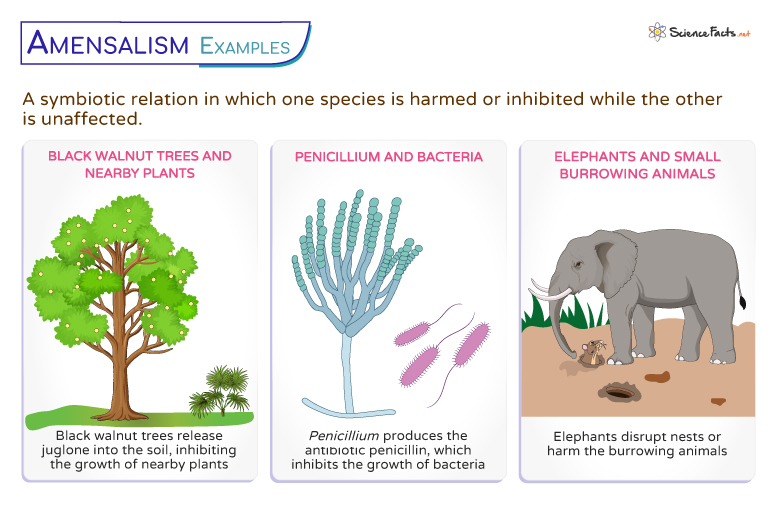Also, ammensalism is not a type of predation or parasitism where one species actively benefits at the expense of another. Instead, ammensalism often arises as a side effect of an organism’s activities without any direct intention to harm or help another.
Types of Amensalism
Examples of Amensalism
Importance of Amensalism
Amensalism vs. Commensalism
1. Antibiosis
The word antibiosis, coined by Vuillemin in 1889-1890, is obtained from the French word ‘antibiosis,’ meaning an antagonistic relationship between organisms. Thus, in antibiosis, one organism produces substances that harm other organisms. These substances can include toxins, chemicals, or metabolic byproducts that inhibit the growth or survival of neighboring species. An example of antibiosis is the release of antibiotics by certain fungi, which can hinder the growth of bacteria in the surrounding environment.
2. Competition
This form of ammensalism arises when one organism actively competes with another for resources, leading to a negative impact on the latter. While the competing organism benefits from this interaction, the other organism is suppressed or inhibited. Competition can exist between an inferior and a superior species or between similar or different species. An example of competition is allelopathy in plants, where one plant species releases chemicals that impede the growth of neighboring plants, giving itself a competitive advantage.
Black Walnut Trees and Nearby Plants
Black walnut trees (Juglans nigra) release a compound called juglone into the soil, which inhibits the growth of many nearby plant species. While the black walnut tree is unaffected by the presence of these neighboring plants, they experience decreased growth due to the allelopathic effects of juglone.
Eucalyptus and Other Plants
Certain trees, like the eucalyptus, release chemicals that inhibit the germination and development of other plant species in their vicinity, a phenomenon known as allelopathy. It produces oils that prevent the growth of most other plants beneath its canopy, creating a zone devoid of competing vegetation.
Penicillium and Bacteria
The mold Penicillium produces penicillin, which acts as an antibiotic. In its natural environment, it secretes penicillin into the surroundings, inhibiting the growth of nearby bacteria. While the mold is unaffected by the bacteria, its antibiotic properties create a zone of inhibition, affecting bacterial populations.
Elephants and Small Burrowing Animals
The movement of large herbivores like elephants can inadvertently disturb burrowing animals such as ground-dwelling rodents. The heavy footsteps of these large animals can collapse burrows, disrupt nests, or even harm the burrowing animals directly. While the herbivores continue their activities without hindrance, the burrowing animals experience negative consequences. Ammensalism helps manage resource allocation and reduces intense competition by inhibiting competitors, fostering a more balanced coexistence. Furthermore, ammensal interactions enhance the resilience of ecosystems, making them better equipped to withstand disturbances. Recognizing and understanding ammensalism is essential for effective conservation and management strategies, ensuring the long-term health and stability of the ecosystems. Amensalism is a (0,-) interaction in which one organism remains unaffected, and the other is harmed. At the same time, commensalism is a (0,+) interaction in which one organism neither benefits nor is harmed, and the other organism derives benefit.
